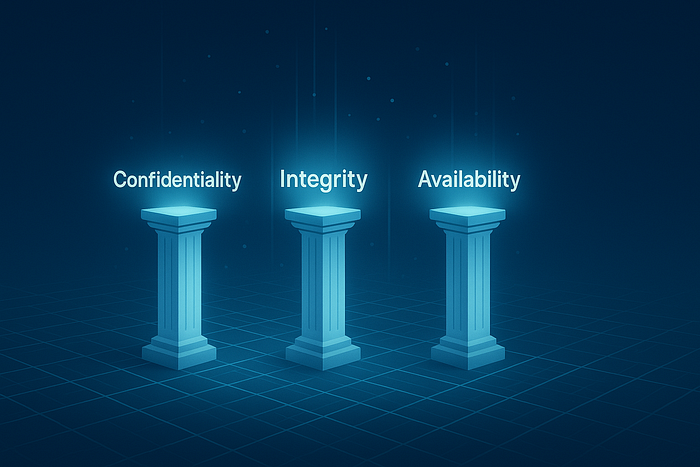Understand the essential building blocks of cybersecurity — Confidentiality, Integrity, Availability, and beyond — and why these principles matter for every digital citizen.
Introduction
Cybersecurity can often feel overwhelming. With so many technical terms, tools, and threats, it's easy to get lost in the details. But at its heart, cybersecurity is guided by a few timeless principles — simple ideas that define how we protect digital information and why it matters.
If you're just starting your journey into cybersecurity, understanding these core principles will give you the foundation to make sense of everything else. They're not just for experts or IT professionals. These principles shape how we secure personal data, business systems, and even national infrastructure.
1. Confidentiality: Keeping Secrets Safe
Imagine writing a private message meant only for your best friend — but someone else reads it before it gets there. That's what cybersecurity tries to prevent through confidentiality.
Confidentiality means ensuring information is only accessible to those who are authorized to see it. It's about keeping secrets safe, whether that's your social media password, medical record, or company financial report.
How it's achieved:
- Encrypting sensitive data during transmission and storage.
- Using authentication methods like passwords, biometrics, or security tokens.
- Limiting access through permissions and user roles.
Everyday example: When you log in to your bank's website, your data is encrypted so only you and the bank can read it — even if someone intercepts the connection.
2. Integrity: Keeping Data Honest
Integrity ensures that data stays accurate, consistent, and unaltered. In other words, what goes in must be what comes out.
If a hacker changes even a single number in a database, the entire system's reliability can collapse. That's why protecting integrity is as crucial as protecting confidentiality.
How it's maintained:
- Using checksums and hashing to verify data accuracy.
- Employing version control systems and backups.
- Implementing access controls to prevent unauthorized modifications.
Everyday example: When you download a software update, your device checks its digital signature to ensure it hasn't been tampered with before installation.
3. Availability: Keeping Systems Running
The best data protection in the world means nothing if you can't access your information when you need it. Availability ensures that data and systems are ready and operational for authorized users — whenever required.
Cyberattacks like DDoS (Distributed Denial of Service) aim to take down websites or services by overwhelming them with traffic, making them unavailable to users. Strong availability planning prevents that.
How it's ensured:
- Using redundant systems and reliable backups.
- Applying regular maintenance and software updates.
- Monitoring system performance to detect unusual activity.
Everyday example: When your favorite streaming platform remains up during peak hours, it's because of strong availability design and load balancing systems.
4. Authentication and Non-Repudiation: Verifying Identity and Trust
Beyond the core CIA Triad (Confidentiality, Integrity, Availability), two other principles strengthen digital trust: Authentication and Non-Repudiation.
- Authentication ensures that the person or system you're communicating with is who they claim to be. Think of it as showing your ID before entering a secure building.
- Non-repudiation ensures that once someone performs a digital action — like signing a contract or sending an email — they can't later deny it. This is made possible through digital signatures and cryptographic proofs.
Together, these principles make digital communication verifiable, traceable, and trustworthy.
Why These Principles Matter
These principles aren't abstract ideas. They form the foundation of every cybersecurity strategy — from securing a smartphone to protecting a multinational company's network.
Ignoring even one of them can create serious vulnerabilities. For example:
- If confidentiality is broken, privacy is lost.
- If integrity is compromised, data becomes unreliable.
- If availability fails, critical services go offline.
Understanding these principles helps you think like a cybersecurity professional. It's not just about defending against hackers — it's about designing trust into every digital experience.
Practical Ways to Apply These Principles Today
Even if you're not a cybersecurity expert, you can start applying these ideas in your daily life:
- Use strong and unique passwords across all your accounts.
- Back up important files regularly to secure locations.
- Keep software updated to avoid security vulnerabilities.
- Verify websites and emails before sharing sensitive information.
- Use encryption on devices and cloud storage whenever possible.
Cybersecurity starts with awareness. By following these principles, you make the digital world safer — not just for yourself, but for everyone connected to you.
Conclusion
Cybersecurity isn't built on fear — it's built on principles. The CIA Triad and its related concepts are the compass that guides every security decision, from engineers designing secure systems to individuals protecting their personal data.
When you understand these principles, you begin to see the digital world differently. You stop being a passive user and become an active defender of your digital environment.
And that's the first step toward a safer internet for all.
